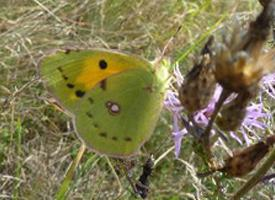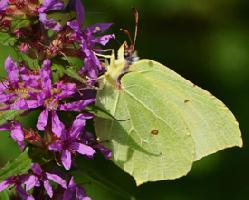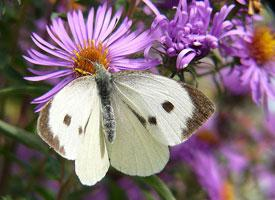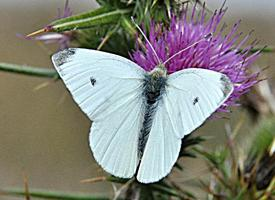
Popis zvířete
The Danube Clouded Yellow, scientifically known as Colias myrmidone, is a fascinating and somewhat elusive butterfly that belongs to the Pieridae family, which is known for its colorful and often strikingly patterned members. This particular species is of significant interest to entomologists and butterfly enthusiasts due to its distinctive appearance and the specificity of its habitat requirements.Characterized by a wingspan ranging from 42 to 50 millimeters, the Danube Clouded Yellow exhibits sexual dimorphism, meaning males and females have different physical appearances. Males typically display a vibrant yellow upper side with a distinctive black border along the edges of their wings, which serves as a striking contrast. The center of the forewing often features a small, dark spot. Females, on the other hand, tend to have a paler yellow or sometimes greenish-yellow coloration with a similar, but often more extensive, black border. Both genders display a lighter, more subdued coloration on the underside of their wings, which can range from yellow to greenish, adorned with faint markings and spots that provide excellent camouflage against predators when the butterfly is at rest.
The habitat of the Danube Clouded Yellow is quite specific, as these butterflies thrive in warm, open areas that are rich in leguminous plants, which are essential for the survival of their larvae. These habitats include flowery meadows, grasslands, and clearings, often near rivers or wetlands, which is indicative of their name "Danube." However, their range is not limited to the vicinity of the Danube River and extends across parts of Eastern Europe and Asia, though populations have been declining in some areas due to habitat loss and environmental changes.
The life cycle of the Danube Clouded Yellow is closely tied to the availability of its larval food plants, which belong primarily to the Fabaceae family. After mating, females lay their eggs on the underside of host plant leaves. The larvae, once hatched, feed on the leaves, growing and eventually pupating to emerge as adults. This species typically has one generation per year, with adults flying from late June to September, depending on the climate of their habitat.
Conservation status of the Danube Clouded Yellow has been a growing concern. In several European countries, their populations have seen significant declines, leading to their classification as threatened or endangered in some regions. The primary threats to their survival include habitat destruction due to agricultural expansion, urbanization, and the intensification of land use. Conservation efforts are focused on habitat preservation and restoration, as well as raising awareness about the importance of this species and its role in the ecosystem.
In summary, the Danube Clouded Yellow is a remarkable butterfly with a distinctive appearance and specific habitat requirements. Its survival is intricately linked to the conservation of its natural habitats, making it a symbol of the delicate balance within ecosystems and the importance of biodiversity conservation efforts.
Podobná zvířata
Nové fotografie zvířat
Top 10 zvířat
- Chinese water dragon (Physignathus cocincinus)
- Galápagos tortoise (Geochelone nigra complex)
- Dolphin gull (Leucophaeus scoresbii)
- Japanese macaque (Macaca fuscata)
- Colombian red howler (Alouatta seniculus)
- Sea urchins (Echinoidea)
- Diana monkey (Cercopithecus diana)
- Moustached guenon (Cercopithecus cephus)
- Common house mosquito (Culex pipiens)
- Colossal squid (Mesonychoteuthis hamiltoni)


